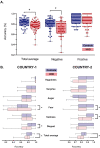Multicentric evidence of emotional impairments in hypertensive heart disease
- PMID: 32839479
- PMCID: PMC7445248
- DOI: 10.1038/s41598-020-70451-x
Multicentric evidence of emotional impairments in hypertensive heart disease
Abstract
The mechanisms underlying emotional alterations constitute a key research target in neuroscience. Emerging evidence indicates that these disruptions can be related to abnormal interoception (i.e., the sensing of visceral feelings), as observed in patients with cardiodynamic deficits. To directly assess these links, we performed the first multicenter study on emotion recognition and interoception in patients with hypertensive heart disease (HHD). Participants from two countries completed a facial emotion recognition test, and a subsample additionally underwent an interoception protocol based on a validated heartbeat detection task. HHD patients from both countries presented deficits in the recognition of overall and negative emotions. Moreover, interoceptive performance was impaired in the HHD group. In addition, a significant association between interoceptive performance and emotion recognition was observed in the control group, but this relation was abolished in the HHD group. All results survived after covariance with cognitive status measures, suggesting they were not biased by general cognitive deficits in the patients. Taken together, these findings suggest that emotional recognition alterations could represent a sui generis deficit in HHD, and that it may be partially explained by the disruption of mechanisms subserving the integration of neuro-visceral signals.
Conflict of interest statement
The authors declare no competing interests.
Figures


References
-
- Barret LF. How emotions are made: the secret life of the brain. Booklist. 2017;113:4–4.
Publication types
MeSH terms
Grants and funding
LinkOut - more resources
Full Text Sources
Medical

